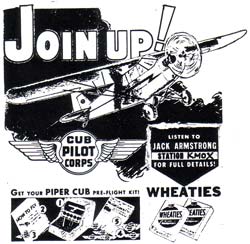|

This story was published in Radio Recall, the journal of the Metropolitan Washington Old-Time Radio Club, published six times per year.
Click here to return to the index of selected articles.
|
|
BUILDING JACK ARMSTRONG’S AIRPLANE
by Fred Fett
(From Radio Recall, June 2006)
The Jack Armstrong Piper Cub Pre-Flight Kit illustration advertising the Wheaties offer, reprinted on the outside cover of the February 2006 issue of the RADIO RECALL, really brought back some very pleasant memories of the adventure-radio days of my childhood growing up in Ohio. (At that time I imagined that Jack Armstrong, himself, had read my letter to him, and had sent me this exciting kit.)

(Click the picture for a larger image.)
My memories of this great kit are as follows. I guess the year may have been 1944 or 1945.
The kit cost two Wheaties boxtops and the proverbial "one thin dime" sent to: Jack Armstrong, C/O Piper Cub Offer, Box 1234, Minneapolis 1, Minnesota. After an excruciatingly long wait of about three weeks, or longer, with me checking the mail-box every day, this highly prized treasure finally arrived.
It arrived in a flat manila envelope which measured about 5 inches by 8 inches in size. Inside of the envelope were four heavy, thick sheets of paper with full-color printing. The thickness of the paper was approximately the same thickness of the wings of the Jack Armstrong paper flyable airplanes. Also included in the kit were information sheets on basic flying instruction including aircraft controls, etc. plus the kit assembly instructions, and a three inch long cylindrical paper “control stick.” This stick was similar to the white paper sticks found in "Tootsie Pop" candy lollipops.
The heavy full-color sheets of heavy paper formed a little box, as shown in the illustration. The completed box was about five inches high, six inches deep, and about four inches wide. Everything needed to complete the finished kit was provided in the envelope, except for some required fine black thread which every kid got from their mother's sewing kit.
Assembling the main box of this Piper Cub kit was quite easy for a ten-year old boy at that time. The outside of the box was a simulated wood-finish color and the front of the finished kit was made to look like the cabin and cockpit of a Piper Cub airplane showing several instrument dials indicating airspeed, altitude, compass heading, fuel-level, etc. The real challenge, however, was to comprehend and execute the very complex instructions regarding correctly attaching and looping the number of fine black threads from the control stick and rudder pedals to various parts of the small yellow airplane inside the box.
So I easily completed assembling the main box of the kit, but I was unable to understand or follow the very detailed instructions for connecting all the black control threads. My mother and father (both from Europe) were not very proficient in English and were unable to help me in this endeavor. My next-door neighbor and close friend,Tom Vogt, who was one grade ahead of me in school, was also unable to follow these complex thread connecting instructions. His mother, and/or his high school sister, did correctly complete connecting the threads in his kit for him. Unlike his working model, my Piper Cub just merely "dangled" inside of the box as a static display and was not maneuverable.
The finished product, when correctly assembled, was a wonderful toy and a great learning instrument. The control stick controlled pitch and roll while the rudder pedals controlled the axis of yaw as in real aircraft. The interior sides of the completed kit were black. In somewhat subdued lighting, the fine black threads controlling the little airplane were not readily visible, thus giving the illusion that this bright yellow miniature Piper Cub was actually in flight in a dark sky and was being accurately and realistically controlled by the kid using the stick and rudder pedals.
This kit was one of the most memorable premiums of the many that I eagerly sent for and joyously received in those exciting days. Later I even "customized" my plane by fashioning a "windscreen" by putting clear scotch tape over the viewing opening of the kit.
Incidentally, exact copies of these vintage 60 plus year-old flyable paper airplanes that we kids enjoyed so much, and which were sent gratis by General Mills to numerous veterans hospitals throughout the United States and overseas for use in the rehabilitation of wounded World War II GIs, are still available today from some school in the Midwest.
Fred Fett is a MWOTRC member in VA who has a large collection of OTR memorabilia.
(Be sure to catch other OTR/aviation-related stories in Radio Recall, including In The Air, On The Air and the three-part Howie Wing series.)
|